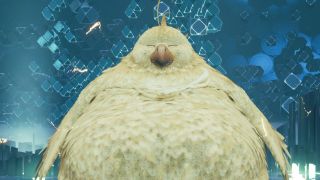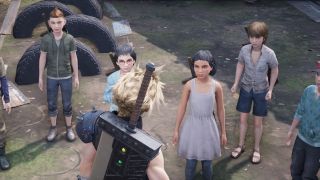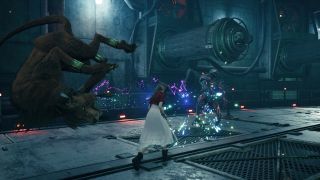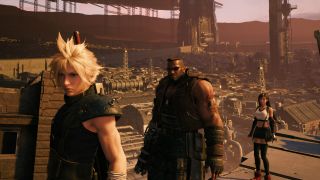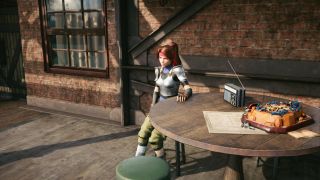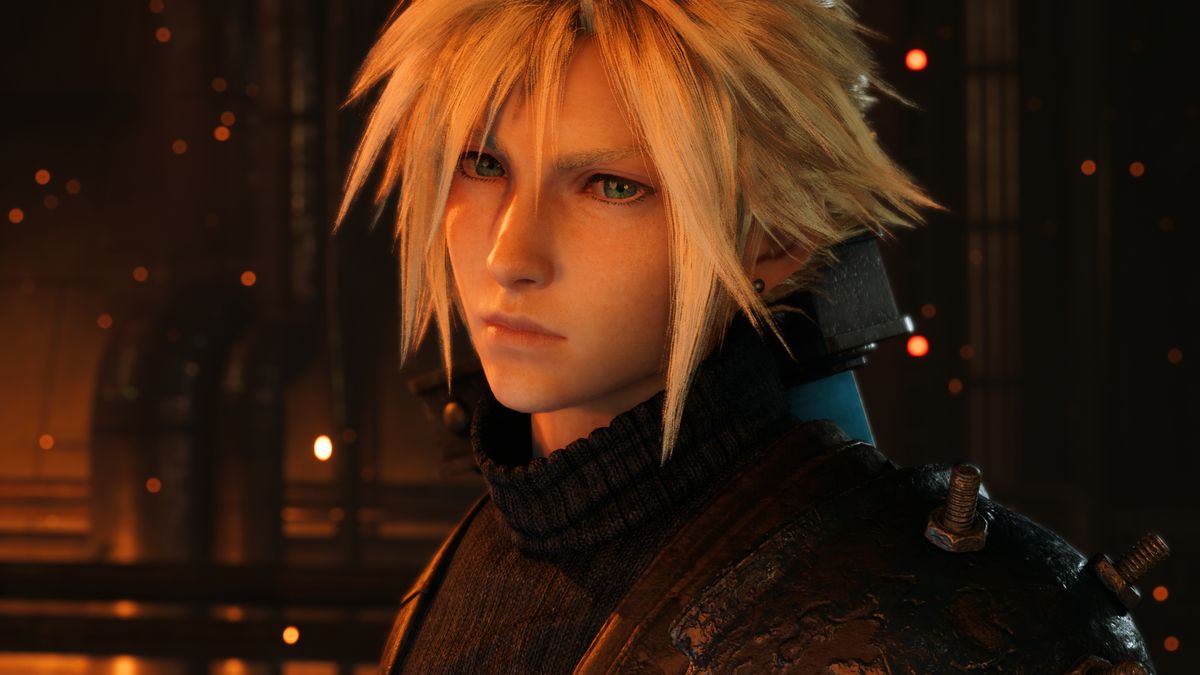
[ad_1]
I didn’t play Final Fantasy 7 when I was a kid. I came here with all the cynicism of a grown adult who doesn’t have time for a half-baked melodrama or infamous urgent work translation that undermines important scenes, like when Tifa tries to jog Cloud’s memory. of an important conversation they had. on a water tower saying “Look, the well”. For starters, it wasn’t a well, and he can’t watch it because you have this flashback in a bar. Tifa, are you drunk right now?
(As Tim Rogers points out in his excellent FF7 Translation YouTube Series, a more precise version of this dialogue would be: “Come on, the water tower? In our village? “)
One of the biggest issues I had with FF7 was its hero. Grumpalump Cloud, Midgar’s most angry pretty boy, brooding in generic rage like an all too typical Western video game man. The first thing Cloud does is tell his eco-terrorist partners he doesn’t care about their names, because that’s how cool and distant he is. What a tool.
Eventually he turned out to be kind of a jerk, that’s how you make a character likable when your audience is nerd, but it’s after hours that he’s acted like a guy who’s never done. to read. Berserk when he was 12 years old. FF7 fans will tell you that Cloud was the first character of his kind, that it was Square Enix who created this tormented Byronic hero model. I’m pretty sure it was Byron, actually.
I never completed FF7, got bogged down in random encounters and eventually gave up. If I had been 13 with all the time in the world maybe I would have, but even then it seems that Midgar on disc one is the part most players remember. That’s why the remake transforming this opening cyberpunk town into its own modern 35-hour prestige video game is just right for me.
In Final Fantasy 7 Remake Cloud still acts stoically and alienatedly, but the contrast between that and the wacky world he finds himself in seems more deliberate. It’s a place where the poor roam riding giant hens, where the manifestation of pure evil is a walking house that shoots missiles, and if you get into trouble you can summon a little cactus to help you. It’s tough being Captain Serious Business when a Lizardman turns you into a toad, or you have to call on Fat Chocobo in a boss fight.
The remake consciously rubs Cloud against the awkwardness of the setting, especially in side quests involving the Slum Children. He wants to be a mercenary, but half of his job is to collect or work directly for the local kids. He participates in their typing game, tracks down their missing cats. A child cosplaying a fuzzy moogle makes him collect “moogle medals†to exchange them for treasures. Cloud’s badass act is constantly deflated by his circumstances, and not just when he puts on a dress.
Eventually, Cloud begins giving the kids a “Toad Kings Special Discount” and tips on how to follow your passion. Contrasting a hardened hero with innocent children is a classic storytelling move, from Lone Wolf and Cub to The Mandalorian, and in Cloud’s case, it forces him to act like an adult instead of the bad teenager. mood he’s of mental age – being a human instead of a stereotype.
This all takes place in the first two sidequest hubs, areas where many new additions to the remake take place. First Tifa then Aerith drag Cloud to their quarters, introducing him to everyone. Tifa’s landlady is particularly unimpressed, telling her not to bother with a guy who has no personality just because he has a “big sword”, a nudge, an elbow nudge.
These sequences add a lot to Midgar, which can feel like an absurd mash-up at times, featuring old-fashioned pickup trucks alongside cyberpunk motorcycles, cowboys, and wizards. The remake doesn’t make Midgar realistic, but it shows the ordinary life of its inhabitants enough that you care if they explode. You want to save these gangs of misfit kids and fiery matrons by fighting for them.
There is of course a lot of fighting.
Hiroyuki Ito, working as a battle designer on Final Fantasy 4, created his Active Time Battle system because he loved Formula 1 racing. Watching the fastest drivers go around the others, he decided to ‘Incorporate speed into what was previously turn-based combat. By FF7, the ATB system was removed. I hated.
The basic idea is that you are only allowed to tell a character what to do once their ATB gauge is full. It’s a game of hurry up and wait. When the gauge fills up there is nothing else to do but watch, and then as soon as it is full you rush through the menus to select an attack or drink a potion or whatever as quickly as possible. All of this so that you can watch the bar fill up again.
The intention was to make you feel pressured, but it creates more annoyance than tension. Either wait for the game to let you play when nothing is happening, or frantically navigate a menu, battling the abstraction that should get in your way. Even if you set it to the mode that interrupts time in menus, you should still wait for the bars to fill up before being allowed to do so.
At first, the combat in FF7 Remake feels like an action game. The characters launch combos, they block and dodge in real time. They still have ATB bars that fill up while this is happening, broken up into chunks that can be spent on special abilities, but if you just watch him play it feels like any other test of your reaction speed in pushing a button. At stake, it is quite another thing.
These dodges don’t have invincibility frames, and some of the attacks have a lot of engagement – Cloud’s great sword needs big liquidations. What matters is spending ATB bars to cast spells or launch special attacks, and those bars fill up much faster when you control a character.
It’s a weird dance and the game doesn’t teach it very well, but the ideal way to play is to jump between characters like a psychic frog, build their ATB bars, choose a special, and then move on to the next one. while the animation is taking place disabled. Cloud has an attack called infinity end which costs two bars and does a bunch of damage, but it takes years to play. Instead of sitting there watching admittedly smooth animation, you jump on someone else and move on to the next move.
It plays into the shift mechanism. Put pressure on an enemy, targeting specific areas, exploiting elemental weaknesses, etc., and they will be stunned. In addition to being unable to attack, staggered enemies take more damage, multiplied by a percentage which can be increased by certain attacks. Push that percentage really high, and when it peaks, you’re in a perfect position to smash a high-damage finisher like the Infinity End.
However, most enemies don’t stay staggered long enough for you to do it this way. Instead, you first place the end of infinity with Cloud, then switch to Tifa and race to get the max multiplier before his shot connects. Do it right, and thousands of health points fall from a giant robot like confetti. He feels good.
Combat isn’t all about that, positioning plays a role – you want to keep Aerith in her arcane room where spells are cast twice, and sometimes characters can gain bonuses by attacking from behind – and flipping things over. of the original as breaks and equipable material. There’s quite a bit of stuff to do, and the keyboard controls are terrible, but it’s the closest thing to realtime combat with pause I’ve ever liked.
It also slyly sheds more light on the main characters’ personalities. Cloud can switch between two combat stances, Operator and Punisher, each based on the style of someone he admired (check the way he stands in each and see who he looks like). Even the way he casts the healing spell is expressive, with a super relaxed hit on the shoulder as if even when he was keeping someone alive, he didn’t want them to know they cared. .
Cloud isn’t the only character whose appeal I understand better now. In FF7 and its spinoff, Aerith sometimes shows herself to be so sane that she might as well be a capybara instead of a woman. In the remake, she’s cunning and smart, and gets some of the funniest lines. And when Cloud puts on his robe, his response is ecstatic in a true “This better not awaken nothing in me” genre. (This whole footage, and the way it’s recontextualized to ditch the original “men wearing dresses are funny” message is way better than I expected.) The entire cast, even the supporting characters minors, has the impression of having an internal life.
If I had been in the right place at the right time, I might have been able to see past FF7’s flaws to realize that its characters were more than just stereotypes when it was released. But the great 1997 RPG I played was Fallout, and by the time I got to FF7, its moment was over. The remake helped me understand why it’s endured, why people wear t-shirts with the heroes’ names on them like they’re the Beatles.
It’s still a shame that the PC port is so dull that I had to run it in DirectX 11 mode to handle the stuttering and plug in a controller to keep minigames from feeling painful, however.
[ad_2]
